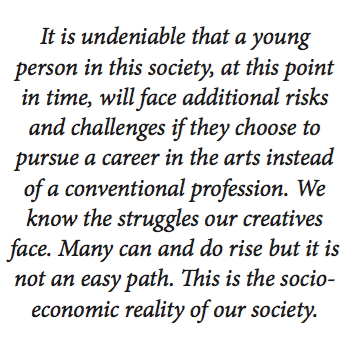It is undeniable that a young person in this society, at this point in time, will face additional risks and challenges if they choose to pursue a career in the arts instead of a conventional profession. We know the struggles our creatives face. Many can and do rise but it is not an easy path. This is the socio-economic reality of our society. The market is ruthless in its laser focus on what people want and need, what they view as valuable enough to spend their money on. That, unfortunately, is the way things work in the current paradigm. We can lament it, we can decry it, but it is useless to deny it. Most importantly, in recognising it, we can do our best to change it.
I see an education and career in the arts as just as ambitious and worthwhile as a career in every other profession - doctor, lawyer, engineer, etc. The problem is not with the pan or with the students, but with our society’s inability to bring the necessary innovation and entrepreneurship into the creative space. To put it another way, we have not been creative enough in supporting our creatives.

Certainly attempts have been made. For decades policymakers have rightly recognised the potential of cultural industries in its strategies to diversify our economy. And there have been successes. But we have much more to do. Let us be clear, the arts have enormous value - material and otherwise. The examples are all around us. Forbes magazine put the value of the global music industry revenue at US$19 billion in 2018. Variety reported in early 2019 that the global film box office was worth US$41.7 billion in 2018. The US publishing industry alone earned US$26 billion in 2018 (Forbes). A PricewaterhouseCoopers report on concerts and music festivals estimated they will bring in US$31 billion worldwide in revenue by 2022.
Closer to home, we have seen how some entertainers, mas bands, event organisers, and participants in the tourism and hospitality business have earned great financial success. This year, the NGC Bocas Lit Fest celebrated 10 years of existence. Through their work in encouraging, training and providing exposure for local writers they have made an enormous contribution to what has in essence become a small but vibrant literary industry. The UWI, through its staff and students, has worked with Bocas from the beginning, and the festival is an inspirational example of what can be achieved through partnership and hard work, driven by genuine passion and a desire to better society.

This past Carnival, one of UWI St Augustine’s own creative projects took place - The Old Yard. This annual event, now in its eleventh year, has helped to rejuvenate many of the older traditions and characters of Carnival. The product of our Department of Creative and Festival Arts, Old Yard is a laboratory or our Carnival Studies and Theatre Arts students. 2020 may have been the biggest Old Yard yet. It was packed with exuberant attendees. This is remarkable considering there were no big-name performers or all-inclusive offering. They came out, paid their money and enjoyed traditional mas’, old-time Carnival performances, stick-fighting and even tamboo bamboo. Art has value.
Old Yard is an example of innovation in festival management. It’s the kind of innovation we need in all aspects of our cultural spheres. Anyone who knows the level of dedication and commitment required to be a great artist in any genre understands how short-sighted it is to dismiss or belittle them or their art form. The farsighted approach would be to invest in them – and not just financially - but through rigorous and creative planning for the growth of their industry.
We have to work towards the day where the parent, and even the students themselves can smile just as wide and feel just as proud reminiscing on a life dedicated to “beating pan”. If that sounds improbable, perhaps the problem is not with our creatives but with the creative imagination of our society.